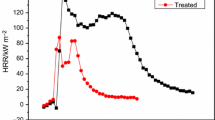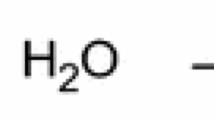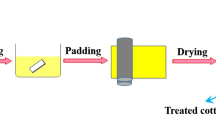Abstract
A novel flame-retardant agent, guanidyl- and phosphorus-containing polysiloxane (GPPDMS), was synthesized. The combustion properties of the cotton fabrics treated with GPPDMS were evaluated by cone calorimeter. The results showed that the TTI value of the treated fabric increased and the value of HRR, THR, EHC, and Mass loss decreased. It demonstrated that the treated cotton fabric with GPPDMS generated less combustion heat and obtained better flame retardancy which can be confirmed by the increase of FPI value and the decrease of CO/CO2 ratio. It also revealed that the cotton fabric treated with 18.6 % (add-on) of GPPDMS had highest reduction in heat of combustion. The chemical structures and morphologies of the residues, and the thermal decomposition behavior of cotton fabrics were investigated by FT-IR, scanning electron microscopy, and thermogravimetric analysis, respectively. The results showed that GPPDMS played a protective role on the degradation of cotton fabrics, hindered the formation of volatile species and favored the formation of char. Furthermore, EDS analysis results showed that remarkable amount of Si and P elements were still present on the surface of fibers after combustion; it indicated that the concurrent presence of Si and P in flame retardant effectively enhances the flame retardancy of cotton fabric.












Similar content being viewed by others
References
Brushlinsky NN, Sokolov SV, Wagner P, Hall JR. World fire statistics. Report No. 10. Centre of fire statistics, international association of fire and rescue service; 2006.www.ctif.org.
Mostashari SM, Mostashari SZ. Combustion pathway of cotton fabrics treated by ammonium sulfate as a flame-retardant studied by TG. J Therm Anal Calorim. 2008;91:437–41.
Horrocks AR. Flame retardant challenges for textiles and fibres: new chemistry versus innovatory solutions. Polym Degrad Stab. 2011;96:377–92.
Alongi J, Ciobanu M, Carosio F, Tata J, Malucelli G. Thermal stability and flame retardancy of polyester, cotton and relative blend textile fabrics treated by sol–gel process. J Appl Polym Sci. 2011;119:1961–9.
Alongi J, Ciobanu M, Malucelli G. Sol–gel treatments for enhancing fire stability of cotton fabrics: optimization of the process and evaluation of durability. Cellulose. 2011;18:167–77.
Alongi J, Carosio F, Malucelli G. Influence of ammonium polyphosphate-/poly(acrylic acid)-based Layer by Layer architectures on the char formation in cotton, polyester and their blends. Polym Degrad Stab. 2012;97:1644–53.
Alongi J, Malucelli G. Cotton treated with novel oxidic phases acting as effective smoke suppressants. Carbohydr Polym. 2012;90:251–60.
Yang SN, Lv GP, Liu Y, Wang Q. Synergism of polysiloxane and zinc borateflame retardant polycarbonate. Polym Degrad Stab. 2013;98:2795–800.
Chen XB, Zhou SX, You B, Wu LM. Mechanical properties and thermal stability of ambient-cured thick polysiloxane coatings prepared by a sol–gel process of organoalkoxysilanes. Prog Org Coat. 2012;74:540–8.
Hu S, Hu Y, Song L, Lu HD. The potential of ferric pyrophosphate for influencing the thermal degradation of cotton fabrics. J Therm Anal Calorim. 2012;109:27–32.
Chen YZ, Peng HQ, Li JH, Xia ZX, Tan H. A novel flame retardant containing phosphorus, nitrogen, and sulfur: synthesis and application in thermoplastic polyurethane. J Therm Anal Calorim. 2014;115:1639–49.
Alongi J, Colleoni C, Rosace G, Malucelli G. Thermal and fire stability of cotton fabrics coated with hybrid phosphorus-doped silica films. J Therm Anal Calorim. 2012;110:1207–16.
Schartel B, Bartholmai M, Knoll U. Some comments on the main fire retardancy mechanisms in polymer nanocomposites. Polym Adv Technol. 2006;17:772–6.
Nazarè S, Kandola B, Horrocks AR. Smoke, CO and CO2 measurements and evaluation using different fire testing techniques for flame retardant unsaturated polyester resin formulations. J Fire Sci. 2008;26:215–42.
Kandola BK, Horrocks AR, Price D, Coleman GV. Flame-retardant treatments of cellulose and their influence on the mechanism of cellulose pyrolysis. J Macromol Sci. 1996;36:721–94.
Tsafack MJ, Levalois-Grützmacher J. Flame retardancy of cotton textiles by plasma-induced graft-polymerization(PIGP). Surf Coat Technol. 2006;201:2599–610.
Brancatelli G, Colleoni C, Massafra MR, Rosace G. Effect of hybrid phosphorus-doped silica thin films produced by sol-gel method on the thermal behavior of cotton fabrics. Polym Degrad Stab. 2011;96:483–90.
Wang CS, Shieh JY, Sun YM. Phosphorus containing PET and PEN by direct esterification. Eur Polym J. 1999;35:1465–72.
Author information
Authors and Affiliations
Corresponding author
Rights and permissions
About this article
Cite this article
Dong, C., Lu, Z., Zhu, P. et al. Combustion behaviors of cotton fabrics treated by a novel guanidyl- and phosphorus-containing polysiloxane flame retardant. J Therm Anal Calorim 119, 349–357 (2015). https://doi.org/10.1007/s10973-014-4154-z
Received:
Accepted:
Published:
Issue Date:
DOI: https://doi.org/10.1007/s10973-014-4154-z




